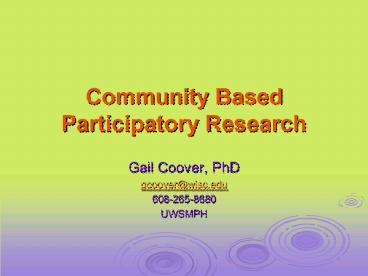Community%20Based%20Participatory%20Research - PowerPoint PPT Presentation
Title:
Community%20Based%20Participatory%20Research
Description:
CBPR results in a lasting and sustainable change---social inequity is reduced. ... What are the hierarchies between me and my partners? ... – PowerPoint PPT presentation
Number of Views:231
Avg rating:3.0/5.0
Title: Community%20Based%20Participatory%20Research
1
Community Based Participatory Research
- Gail Coover, PhD
- gcoover_at_wisc.edu
- 608-265-8680
- UWSMPH
2
Sent Monday
- Also, if you have specific questions/interests
regarding CBPR, please e-mail them to Gail Coover
ltgcoover_at_wisc.edugt before the workshop.
3
- The Examining Community-Institutional
Partnerships for Prevention Research Group,
(2006). - Developing and Sustaining Community-Based
Participatory Research Partnerships A Skill
Building Curriculum. - www.cbprcurriculum.info
4
Community-Based Participatory Research
- What is CBPR?
- Why is it useful?
- What is knowledge, attitudes, skills are needed?
- Where are resources for support?
5
CBPR
- A paradigm, strategy, or approach
6
(No Transcript)
7
CBPR
- Requires a collaborative relationship with the
community - Co-learning, Co-teaching, Co-service, Co-operation
8
(No Transcript)
9
In participatory action research
- Community members partner with researchers to
- Define research questions
- Design and implement research
- Interpret, disseminate, and apply results
10
Ideally,
- CBPR results in a lasting and sustainable
change---social inequity is reduced. - Change occurs at collective/community level
11
Why use CBPR?
- Health Disparities
- Persistent
- Complex
- Linkages to social-ecological factors
12
Diabetes Be-aWare
13
Where does an intervention fit?
14
Why CBPR?
- Communities make it a condition of their
participation
15
- Dilemma Youve partnered with an organization
and have received funding to develop an
intervention (exercise program) that will support
healthy weight loss. Your proposal describes an
RCT of the intervention. The organization refuses
to continue unless all members have equal access
to the program.
16
(No Transcript)
17
Knowledge, Attitudes, and Skills
- Institutional Resources
- Wisconsin Partnership Program (partnership)
http//www.wphf.med.wisc.edu - Morgridge Center for Public Service (learning)
http//www.morgridge.wisc.edu - ICTR-CAP (research) http//www.uwictr.wisc.edu/no
de/102division - Center for the Study of Cultural Diversity in
Healthcare (support) http//cdh.med.wisc.edu/ - Courses (training)
- 436-875 Special topics seminar in CBPR this fall
- Certificate in Type II Translational Research
Fall 2009
18
Knowledge, Attitudes, Skills
- Web Resources
- Community-Campus Partnerships for Health (CCPH)
http//www.ccph.info - MapCruzin (Environmental Health)
http//www.mapcruzin.com/ - U.S. Department of Health and Human Services
Agency for Healthcare Research and Quality
http//www.ahrq.gov
19
Knowledge, Attitudes, Skills
- Community perspectives1
- Dissatisfaction with the focus of research
- Power imbalances
- Lack of trust
- Communication difficulties
- 1 Sullivan et al., (2001). Researcher and
Researched-Community Perspectives Toward
Bridging the Gap. Health Education Behavior,
28, 130-149.
20
Knowledge, Attitudes, Skills
- Successful Collaborations
- Early involvement of communities
- Power sharing
- Mutual respect
- Community benefit
- Cultural sensitivity
21
Relationship Dynamics
22
Relationship Dynamics
- Difference necessarily means bias will be
present2,3 - Cognitive
- Emotional
- 2 Pettigrew Tropp, (2006). A Meta-Analytic
Test of Intergroup Contact Theory. JPSP, 90,
751-783. - 3 Staggs, S. (2008). Intergroup Relations in
Participatory Research. University of Illinois,
Chicago.
23
Necessary Conditions to Reduce/Eliminate Bias
- Shared Goal
24
Social Ecological Perspective
25
Some questions to ask
- How do I know my community partners and I share
the same goal? - How do I know we mean the same thing when we talk
about our goals? - What are the different ways that my community
partners can express their goals to me?
26
Strategies to Reduce Bias
- Endorsement of the collaboration
27
Some questions to ask
- Is my research partnership with the community
supported and endorsed by my funder? My
department? My program? - Is my community partners relationship with me
endorsed by its board of directors? By other
boards or agencies that the organization is
networked with? By key public activists in the
community?
28
Strategies to Reduce Bias
- Cooperative work on a shared task.
29
Questions to ask
- Whose work is affected, assumed, or changed by
this project? - What tasks can be shared and accomplished
cooperatively (side by side)?
30
Strategies to Reduce Bias
- Create equity between all parties
31
Questions to ask
- What resources do I bring to the table?
- What resources do my partners bring to the table?
- What is are the hierarchical relationships
between my community partners? - What are the hierarchies between me and my
partners? - How are these hierarchies addressed, reinforced,
or accommodated? - Who talks to whom about what parts of the
project? Who defines roles? Who reports to whom?
32
Thank you!































